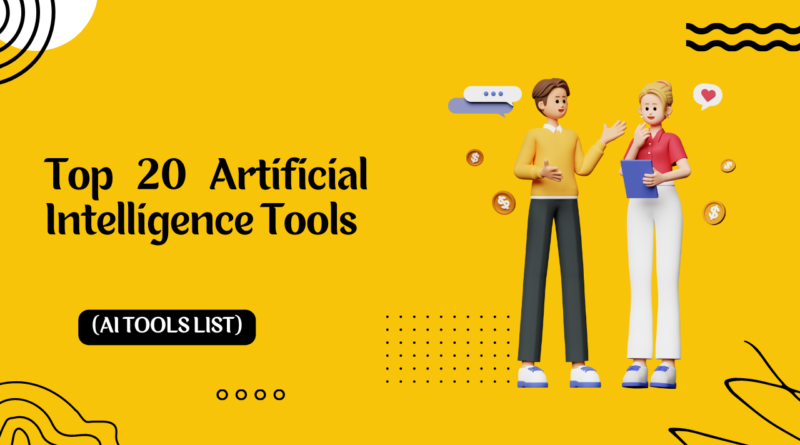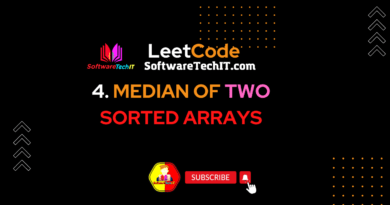Top 20 Artificial Intelligence Tools (AI Tools List) In the Market – 2023 Like ChatGPT
Table of Contents
When it comes to artificial intelligence, there has been a lot of advancement and growth throughout the years. The majority of this development has been focused on the expansion of enterprises and industries. A number of businesses are developing artificial intelligence products suitable for personal use, nevertheless. Our selection of the top 20 AI tools list for 2023 includes a variety of capabilities and applications, such as natural language processing and predictive analytics, to help you choose the right tool for you. Keep reading to find out more about it.
Introduction to AI
Artificial intelligence, sometimes known as AI, is the creation of computer systems that are able to carry out operations that ordinarily require human intellect, such as learning, reasoning, problem-solving, and pattern recognition. When it comes to artificial intelligence, there has been a lot of advancement and growth throughout the years. The majority of this development has been focused on the expansion of enterprises and industries.
Several businesses are developing artificial intelligence products suitable for personal use, nevertheless. Several industries, including healthcare, banking, marketing, and transportation, have used AI in diverse ways, and it is quickly changing how we live and work. Self-driving vehicles, virtual assistants, recommendation systems, fraud detection algorithms, and picture recognition software are a few examples of AI-powered technology. With all the advancements in technology and information technology, artificial intelligence is hailed as the next big thing.
Types of AI Tools
- Machine learning platforms: These tools employ algorithms to find patterns in huge datasets, then use those patterns to forecast the future or make judgements. They may be used for things like fraud detection, natural language processing, and predictive analytics.
- NLP Tools: Language translation, sentiment analysis, and speech recognition are just a few of the activities that natural language processing (NLP) systems may carry out by analysing and comprehending human language.
- Computer vision tools: These tools analyse photos and videos using deep learning algorithms, which enables them to carry out tasks like object detection, image categorization, and facial recognition.
- Robotics Tools: With the use of these tools, robots may be programmed and controlled to carry out jobs like manufacturing, shipping, and customer service.
- Speech Recognition Tools: Technologies for speech recognition and synthesis are employed to record, comprehend, and produce synthetic speech with a natural-sounding voice.
- Virtual Assistant Tools: Technologies for creating conversational interfaces that can respond to queries and carry out activities include chatbots and virtual assistants. These tools make use of natural language processing and machine learning.
- Tools for detecting fraud: These programmes employ data analysis and machine learning to spot fraudulent behaviours including identity theft and credit card fraud.
- Tools for Personalization: These tools make use of machine learning to give consumers individualised experiences, including suggestions for products and content.
- no code ai tools: no-code ai tools.
Benefits of Ai tools
Here are some of the key benefits of using ai tools over regular ones.
- Higher Efficiency
- Increased Accuracy
- Lower Costs
- Personalization options
- Superior Customer Service
- Improved decision-making
- Increased output
Top 20 AI Tools to use in 2023
Here’s a list of ai tools.
1. Adept
Adept is a machine learning research and product lab that develops general intelligence by empowering human and computer collaboration. It is advantageous for firms that want to learn from their data since it provides tools for data analytics, predictive modelling, and automated reporting. Adept may be integrated with current workflows and systems and leverages cutting-edge machine learning techniques to deliver precise forecasts and insights.
Based on the demands and objectives of each organisation, customised pricing is offered by Adept.
Features:
- Modeling predictions
- Data analysis
- Automated reporting
- Adaptation to current processes and systems
2. Quillbot
Quillbot is an AI-powered writing helper that provides tools for rewriting, summarising, and improving content. It may provide suggestions for improvements to sentence structure and writing style and employs machine learning techniques to find grammatical and spelling mistakes. Students, authors, and corporations looking to increase the calibre of their written content may all benefit from Quillbot.
Benefits:
- Can be used as a paraphraser.
- Possess the ability to act as a grammar checker.
- Has a Summarizer built in.
- Citation generator.
3. Covarient
An AI-powered robotics platform called Covariant provides capabilities for automatic object coordination, manipulation, and recognition. A variety of businesses, including manufacturing and logistics, can use it. Covariant use machine learning algorithms to teach robots from their surroundings and adapt to new jobs and conditions.
Covariant also offers custom pricing for it’s users as per their needs.
Features:
- Robotics development using machine learning.
- Visual object recognition system.
- Flexibility to handle various robotic programs.
- Adaptation to current systems.
- Real-time analytics for vigilance and improvement.
4. Bard
The writing helper Bard uses artificial intelligence to provide tools for enhancing the organisation, consistency, and style of written material. Bard was introduced recently by Google and currently available only to the beta testers. It can spot grammatical and spelling mistakes, and it makes recommendations for writing style and coherence improvements using machine learning methods. For authors, bloggers, and companies who desire to raise the calibre of their written content, Bard can be helpful.
Features:
- Chatbot platform with AI.
- Ability to process natural language.
- Adaptation to websites and messaging applications.
- Adaptable chatbot behaviour and design.
5. ChatGPT
ChatGPT is an interactive AI assistant that answers user enquiries with pertinent and personalised information. It can be connected to several communication platforms, including Facebook Messenger and Slack. ChatGPT makes use of sophisticated machine-learning methods to decipher user questions and provide accurate and appropriate responses.
It is a free tool to use.
Features:
- Responds to user questions with tailored and thorough information
- No word count is set for creating content.
- Programmed to reject unreasonable requests.
- Ability to recall details of past interactions.
ALSO READ: 15 Best AI Writing Tools Every Writer Must Learn to Use
6. Bing AI
Bing Ai is another interactive assistant that was recently introduced by Microsoft. The Bing search engine includes several artificial intelligence technologies and capabilities called Bing AI. The AI technologies give tailored suggestions, boost picture and video search capabilities, and assist to increase the accuracy of search results.
Features:
- Powered by AI technologies from Microsoft.
- Offers intelligent search results, picture and audio recognition.
- Natural language processing.
- Used across many platforms and apps.
7. Replika
Replika is a chatbot with artificial intelligence (AI) that mimics human communication. The chatbot may offer emotional support, individualised advise, and even participate in philosophical debates. It is built to learn from its interactions with people.
Features:
- A chatbot driven by AI that is designed to offer comfort and company.
- Creates human-like conversations using machine learning and natural language processing.
- Provides consumers with possibilities for customisation.
8. Anthropic
Anthropic is a successful startup that does AI research to develop “robust and interpretable machine learning systems.” The company’s technology is meant to make AI use more ethical and responsible while also making it more transparent and clear.
Features:
- Provides resources and technology for building moral and transparent AI systems.
- Has instruments for evaluating fairness, troubleshooting models, and interpreting results.
- Used by companies and researchers to make sure their artificial intelligence (AI) systems are moral and open.
9. GitHub Copilot
Copilot is one of the ai development tools, it is developed by Microsoft owned Github.
Features of Copilot:
10. Google Assistant
The voice-activated, AI-powered virtual assistant known as Google Assistant was created by Google. Users of the assistant may use it to create reminders, send messages, and seek directions, among other things.
Features:
- Google’s artificial intelligence (AI)-powered virtual assistant
- Provides functions including voice-activated search, smart home control, and tailored suggestions.
- Various devices and apps are integrated within.
11. Siri
Apple’s AI-powered virtual assistant with speech recognition is called Siri. It is also one of the popular AI assistants. Making phone calls, sending messages, and playing music are just a few of the duties the assistant is designed to aid customers with.
Features:
- Siri on the iPhone can announce calls, texts, and more.
- Apple Music Voice and Siri may both be used to play music on an iPhone.
- Using Siri on your iPhone, manage your house.
- With an iPhone, use Siri, Maps, or the Maps widget to find directions.
12. Alexa
The AI-powered virtual assistant Alexa is an Amazon product. The virtual assistant is made to aid users with a range of activities, such as creating reminders, placing calls, and managing smart home appliances.
Features:
- You can ask about current events and trivia.
- Get advice and ideas for cooking.
- You can play games and listen to music.
- Remind someone of a schedule or a medication.
- Multilingual support.
13. Grammarly
One of the greatest online AI writing tools is Grammarly. Grammarly is a writing helper driven by AI that provides real-time suggestions for grammar and spelling corrections as users type. It may be incorporated into many other programmes, such as word processors, social networking sites, and email.
Features:
- Eliminates grammatical mistakes.
- Makes sure your spelling is accurate in the right context.
- Use punctuation correction for all of your punctuation demands.
- Google docs and Google Chrome along with Microsoft word integration.
14. Jasper
With the help of the generative AI platform Jasper, your team can create content that is uniquely suited to your brand. With Jasper, you may create your own blogs, articles, books, scripts, and other types of content. All you have to do is choose a subject, fill out the form with your details, and Jasper will produce the content.
Features:
- Create long texts with the help of AI.
- Plagiarism Integrated Finder
- Integration of SEO Surfer for optimization and keyword research
- Support for the AI Wizard’s sentence generation.
Also Read: 10 Amazing AI Marketing Tools Marketers Must Know About
15. OpenCV
An open-source computer vision library called OpenCV provides a number of functions for processing both still and moving images. Robotics, surveillance, and augmented reality are just a few of the applications that the cross-platform framework may be used for.
Features:
- Open-source library for computer vision.
- Provides features including facial recognition, object identification, and image and video processing.
- Used in a range of computer vision research and applications.
16. TensorFlow
The open-source platform ensorFlow is used to create and train machine learning models. The platform provides a number of features, such as pre-built APIs, data pretreatment tools, and a flexible architecture that can be used to build different types of models.
Features:
- Open-source machine learning library developed by Google.
- Provides capabilities including deep learning, neural network creation, and model deployment.
- Used by companies and academics to create and implement machine learning models
17. Watson
IBM’s Watson is a collection of AI-enabled tools and services. The platform provides a number of functions, such as predictive analytics, picture and audio recognition, and natural language processing.
Features:
- Predictive analytics, machine learning.
- Natural language processing.
- Used in a multitude of fields, such as customer service, banking, and healthcare.
18. Dall-E
OpenAI created the Dall-E picture generator, which uses AI. The programme is intended to produce distinctive, realistic visuals from written descriptions.
Features:
- Using deep learning and natural language processing, the OpenAI AI-powered picture production system can produce images from written descriptions.
- Used to create images for use in artistic and creative applications as well as for commercial purposes.
19. Remini
Remini is an AI-driven programme for enhancing and restoring antique pictures. The tool may enhance image quality, eliminate flaws and scratches, and add colour to monochrome photographs.
Features:
- Ai-powered picture improvement tool to improve and restore low-resolution photographs.
- Accessible as a mobile app for devices running iOS and Android.
- Can generate realistic-looking Avatars from Pictures.
20. Playground AI
Playground is another free AI image generator where you can add instructions and generate high-quality images or graphics for free. You can utilise these images in social media posts, blogs and articles.
Features:
- Free Dall-E2 picture creation is provided.
- The prompt is automatically filled up using the desired art style.
- It can upscale your images for free.
- It saves images on the server.
- It’s a social media for AI-generated images.
Application of AI in modern World (ai business tools)
Here are some of the most widely used applications of Ai Tools in today’s world:
AI IN EDUCATION / AI RESEARCH TOOLS
Artificial intelligence (AI) is gradually making its way into the educational field, helping to boost efficiency and putting a greater emphasis on students than on office or administrative tasks. It may be used to automate office procedures, provide intelligent content, customise education, and offer voice assistants. It can also be used to monitor students’ data and generate habits, lesson plans, reminders, study guides, flash notes, frequency or revision, etc. to create a rich learning experience.
AI IN E-COMMERCE
To enhance consumer experience and lower credit card theft, artificial intelligence technology is employed to construct recommendation engines and virtual shopping assistants. Chatbots may interact with consumers in real-time, and AI-powered assistants employ natural language processing to make the dialogue feel human and intimate. Two of the biggest problems E-Commerce businesses have are credit card theft and bogus reviews. Artificial intelligence (AI) can assist in spotting and handling false reviews.
AI IN LIFESTYLE
Autonomous cars, spam filters, face recognition, recommendation systems, and other aspects of AI have a significant impact on our way of life. Autonomous cars employ object detection to prevent accidents, spam filters to remove spam, face recognition to detect and identify for secure access, and machine learning to educate computers to think and grow like people. In order to boost user engagement, recommendation systems gather user data and provide consumers personalised recommendations. Almost all sectors make extensive use of these applications.
AI IN NAVIGATION
To increase the precision, effectiveness, and safety of navigation and location-based services, artificial intelligence (AI) is being employed more and more in the navigation sector. Real-time traffic data is analysed by AI algorithms to determine the most effective routes, forecast vehicle maintenance requirements, and offer individualised suggestions for attractions along a route. While autonomous vehicle technology driven by AI has the potential to revolutionise transportation by lowering accidents, boosting efficiency, and removing the need for human drivers, it can also deliver real-time updates on traffic, weather, and other factors.
AI IN HEALTHCARE
By offering a wide range of possible applications to enhance patient outcomes, lower costs, and boost efficiency, AI is transforming healthcare. AI algorithms can detect illnesses, interpret medical pictures more accurately than people, and help design new drugs. Chatbots can help with patient triage and can offer answers to frequent health-related concerns, while virtual nursing assistants powered by AI can monitor and support patients around-the-clock. AI may be used to develop individualized treatment regimens, track the course of diseases, and identify people who are at risk of developing particular ailments.
AI IN SOCIAL MEDIA
AI is becoming more and more significant in social media platforms, offering a variety of applications to enhance user experiences and boost platform effectiveness. AI algorithms may be used to tailor information and advertisements for users, identify fake news and hate speech, and suggest accounts to follow that are relevant to them. AI can help with spam filtering and content moderation by highlighting potentially damaging information for evaluation. AI-powered chatbots may also be utilized to offer real-time customer service and respond to consumer inquiries.
AI IN MARKETING / AI DESIGN TOOLS
By offering a wide range of applications to enhance targeting, personalization, and efficiency, AI is revolutionizing the marketing sector. Huge volumes of data may be analyzed by AI systems to find trends and preferences, enabling targeted advertising and individualized marketing efforts. Chatbots powered by AI may also offer in-person customer service and respond to frequently asked inquiries, freeing up marketing employees to concentrate on more difficult jobs. AI may also help with lead creation, lead prediction, price optimization, and product positioning, among other tasks.
AI AS CHATBOTS
A variety of businesses are seeing an increase in the use of AI-powered chatbots, which offer a quick and affordable method to respond to client questions and offer help. Chatbots offer 24/7 personalized help and support by understanding and responding to user inquiries using natural language processing and machine learning techniques. Chatbots may help with a variety of activities, such as organizing appointments, making product suggestions, and responding to frequently asked queries. Chatbots may help organizations lower costs by processing a large volume of enquiries without the need for human participation, in addition to enhancing customer happiness.
FAQs
1. What are the most widely used AI tools on the market?
Depending on the sector, different AI tools are more commonly utilised, however some of the most well-known ones are Chat GPT, Watson, Google Assistant, Siri, Alexa, Grammarly, OpenCV, and SEMrush.
2. How do I choose the best AI tool for my company’s needs?
Taking into account your business objectives, the sort of data you have, and the difficulty of the tasks you want the tool to complete will help you identify the ideal AI tool for your company’s requirements.
3. Are AI tools challenging for those without technical backgrounds to use?
Even while certain AI solutions might need technical know-how to set up and install, many manufacturers are attempting to make their tools more accessible and user-friendly for non-technical users.
4. How much are AI tools usually going to cost?
The price of AI tools can vary greatly depending on the seller, the capabilities offered, and the difficulty of the jobs they are capable of completing. Some tools could cost thousands of dollars per month or more, while some might be offered for free or with a freemium pricing model.
5. Is it possible to incorporate AI technologies with other business software?
Yes, it is frequently possible to use APIs, plugins, or custom interfaces to combine AI technologies with other business applications. The particular requirements, however, will vary depending on the equipment and software you’re utilizing.
6. Do I need a dedicated data scientist on staff if I want to use AI tools correctly?
It’s not always required to have a specialized data scientist on staff; however, it might help to harness the advantages of AI tools.
7. What are AI tools?
AI Tools are machine learnings applications and tools that are trained on large data sets to perform a specific task. For example, GitHub Copilot is trained on code on open source applications to create an AI tool that can generate code.
8. Which is the best AI tool? (What are some of the main tools in AI?)
There are many great AI tools in the market depending on your use case and needs. Some of the widely popular AI tools are: ChatGPT, Copilot, DALL-E, BARD, etc.
9. What is the most popular AI?
As of 2023, ChatGPT by OpenAI is the most popular AI tool on the Internet and around the world. ChatGPT is a text based Natural Language processing AI tool, which means that users can ask ChatGPT any question it’ll try to answer it best given the data sets it was trained on. Which makes it very easy to use. It crossed 5 million+ users within days of launching.
Conclusion
In conclusion, the fast advancement of artificial intelligence (AI) has produced a wide range of tools that are revolutionising several fields of endeavour and spurring creativity. The top 20 AI solutions projected to dominate the market in 2023 show how AI has the enormous potential to boost productivity, customer happiness, and overall performance.
These artificial intelligence (AI) technologies are providing a variety of features and applications that are altering the way people work and interact with technology, from picture identification to speech analysis, chatbots, and recommendation systems. It is possible that even more potent tools will be created as AI develops, opening up countless opportunities for both corporations and people.





